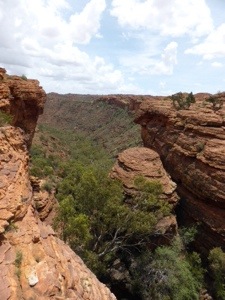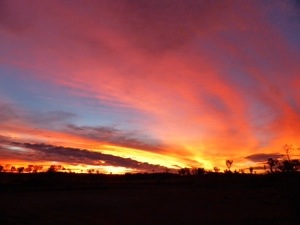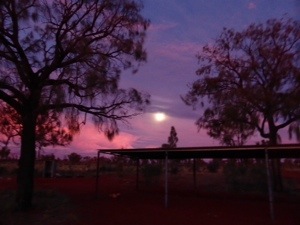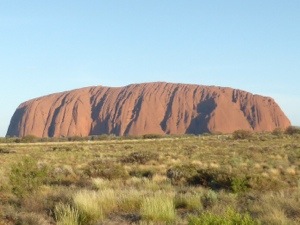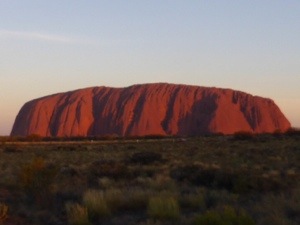Uluru (Ayers Rock) really is something special. It justifies its hype, and despite all the photographs seen of this great rock in the desert, it is still surprising what a stunning spectacle it is. I spent three days camping out under the stars and hiking around the various impressive rock formations in the area. By ‘in the area’ I mean about a three hour round trip by road. The journey here demonstrated just how remote this part of Australia is. From Alice Springs it is another six hour bus journey to Kings Canyon (Watarrka) (over 500km), where we first visited and were lucky with the weather to be able to go hiking. Temperatures registering too hot, or setting out too late in the day (after around 8am) mean that it is not possible to explore the scenery in the same way. The risks are too great. Temperatures are generally around forty degrees centigrade and help can be a long way off.
The weather was kind, and setting off early, in temperatures in the mid thirties with a bit of a breeze felt really very comfortable. Instructed to carry a litre of water for every hour you are walking meant advice of drinking three litres of water over the course of the 7km hike. Dehydration is the biggest risk, and a very serious one. Having been instructed so carefully during the day left us utterly gullible for the later ‘words of wisdom’ when setting up camp for the night. It was beautiful, completely isolated in the outback with the full 360 degree horizon filled with ambers, pinks and blues as the sun set and we busied ourselves lighting a fire to cook dinner. Nothing interrupted the view in any direction. On one side I could see the fat round moon, and on the other a distant lightening storm. As the sun dropped further, the moon glowed brighter and the stars became increasingly twinkly. I was travelling with a group of about 12 for this trip, and as we all set out our swags on the ground around the fire, we received our first instructions on survival. Sleeping in the open in the outback is not without its dangers. As everyone knows, everything in Australia can kill you. I have even seen flowers with this warning. Snakes, spiders, crocodiles, sharks, dingos. If the climate doesn’t get you, one of the locals will. So, midst desert we were pretty clear of any crocodiles or sharks (the risk from which is also up for discussion anyhow, I may well come back to this another time), but the remaining three had particular ‘survivial’ strategies. Now, having introduced this as I have you are no doubt expecting what I (and most, if not all of the rest of the group) wasn’t. We dutifully drew our circles around our swags with a stick, believing that snakes do not cross an unbroken line. We also sprinkled sugar around our swags to deter spiders, what I didn’t do was get a rock to throw at approaching dingos. The spell of myth was finally broken when, on day 3, we were told to dab Vegemite behind our ears to protect us from ‘drop bears’. It must be great fun working as a tour guide sometimes. I still drew my circle though, it had worked so far.
Day two took us to Kata Tjuta (The Olgas) which was I think the best days walking. The name means ‘many heads’ and from a distance you can see why. What looks like a line of large rounded rocks at various angles is certainly an intriguing sight. Again, surrounded by an inordinate amount of flat desert, the fact that these exist where they exist is captivating. As with Kings Canyon, there is only a section which is accessible to visitors, much of the site deemed sacred. It continues to be inhabited by aboriginal groups and used for special rituals and teachings. Nonetheless we managed to spend another three hours hiking around and through the area, completing the Valley of the Winds walk, which was generally regarded as the most enjoyable walk of the trip. More challenging and also more visually stimulating – it is hard to get this across in photographs, the scale is such that it cannot be captured in one image. True to its name it was also windy, which again made for a more comfortable days excursion.
That evening brought our first glimpse of Uluru. A trip to see it at sunset. The sunset was not the most spectacular ever seen, but the light changing on the surface of the rock during the sun’s descent created a mesmerising sight. The same pattern was seen the next morning at sunrise, the changing light reflections proving much more interesting than the sunrise itself. Then chance to get up close and complete the base walk, conveniently about another three hours. This 10.6km loop takes you, as you might expect, around the entire circumference, with chance to see the significant marks and formations depicted in many ‘dreamtime’ stories and the basis of rituals and teachings within the Anangu people, some of which are so sacred they are off limits for photographs. The site is a particularly sacred one, the level of which I have only a very limited understanding. The network of stories, laws, ceremonies and teachings connected with it are many and complex. As a non-aborigine I am only able to learn a small amount. Various rites of passage and responsibilities bring the chance to be told more. What is clear is that the Anangu people do not want Uluru to be climbed. This is partly because they feel very responsible when someone falls and dies, which they invariably do, and also because it is such a special site, only a very select number of people within the tribe are allowed to climb it as a part of a special ceremony. The Anangu are described as the traditional owners, currently leasing Uluru and Kata Tjuta National Park to the Federal Government on a 99 year lease. They have been recognised as the traditional owners since 1985 when the title deeds were handed back to the Anangu. They now work in partnership with the director of National Parks to jointly manage the site. It is hoped that the ability to climb the rock will be withdrawn in the near future, the last member of the board who continues to want it to be climbed is the Minister for Tourism. Everyone else are united in holding a wish to close it. People continue to climb despite the Anangu’s polite requests, and despite the park’s warnings of risks during certain weather conditions. It has become a more treacherous climb over time due to the wear, many footsteps making for a slippery surface and a visible scar can be seen. For me the most impressive view was of it, not from it. Drawing up to Uluru it makes for an imposing view. Fortunate that it is low season, and therefore not particularly populated, held the opportunity to stand and gaze in relative privacy. As the Anangu people say “The real thing is listening to everything”. Chance to listen to it and stand in it’s shadow was quite powerful. There is something very special about it on an emotional level. There is also something very special about it on a very physical level. Created by the Peterman Shift, the land moved 80 degrees, resulting in the rock standing 348m above the ground and 600m below it. One side of the rock is 500 million years older than the other. This is, whatever your spiritual beliefs, a pretty special rock.

